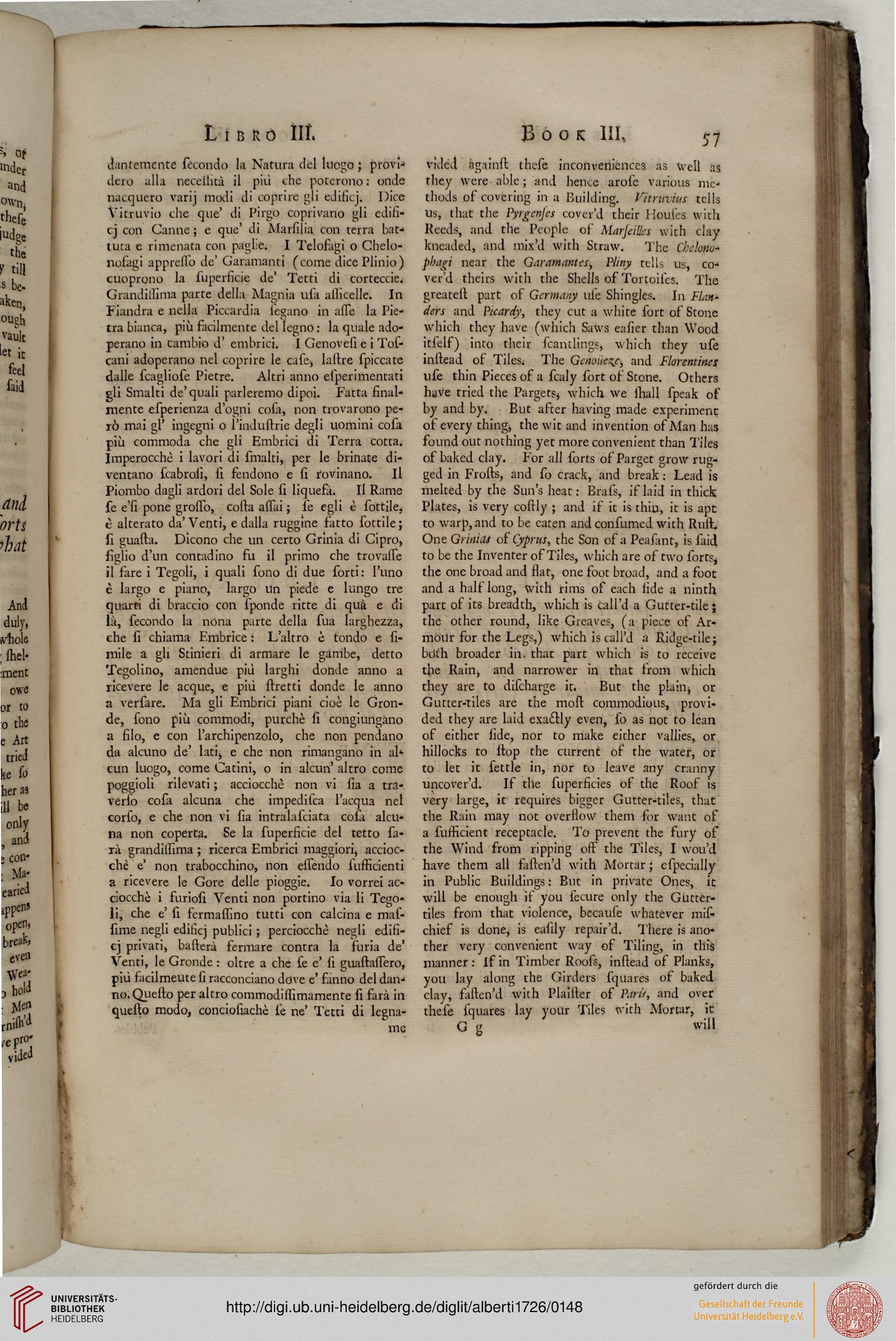Libro III.
Jantemcnte secondo la Natura del luogo ; provi-'
dcro alla necdhtà 11 più che poterono : onde
nacquero varij modi di coprire "li edificj. Dice
Virruvio che que' di Pirgo coprivano gli edili-
cj con Canne ; e que' di Marsiiia con terra bat"
tura e rimenata con paghe. I Telofagi o Chclo-
nosagi appretto de' Garamanti (come dice Plinio)
cuoprono la superficie de' Tetti di corteccia
Grandillima parte della Magràa usa alliccile. In
fiandra e nella Piccardia legano in alse la Pie-
tra bianca, più fàcilmente del legno : la quale ado-
perano in cambio d- embrici. I Genovesi e i Tot-
cani adoperano nel coprire le case, lallre spiccate
dalle scagliose Pietre. Altri anno esperimentati
gli Smalti de'quali parleremo dipoi. Fatta final-
mente esperienza d'ogni cola, non trovarono pe-
rò mai gì' ingegni o l'induitrie degli uomini cosa
più commoda che gli Embrici di Terra cotta.
Imperocché i lavori eli {malti, per le brinate di-
ventano scabroli, si fendono e si rovinano. Il
Piombo dagli ardori del Sole li liquefa. Il Rame
sé e'ii pone grosTo, cosla alsui ; sé egli è sottile,
t alterato da' Venti, e dalla ruggine fatto sottile ;
st guada. Dicono che un certo Grinia di Cipro,
figlio d'un contadino fu il primo che trovalse
il fare i Tegoli, i quali sono di due sorti: l'uno
è largo e piano, largo un piede e lungo tre
quarti di braccio con sponde ritte di qua e di
là, secondo la nona parte della sila larghezza,
che si chiama Embrice : L'altro è tondo e li-
mile a gli Stinieri di armare le gambe, detto
Tcgolino, amendue più larghi donde anno a
ricevere le acque, e più {fretti donde le anno
a versare. Ma gli Embrici piani cioè le Gron-
de, sono più commodi, purché lì congiungàno
a filo, e con l'archipenzolo, che non pendano
da alcuno de' lati, e che non rimangano in al-
cun luogo, come Catini, o in alcun' altro come
poggioli rilevati ; acciocché non vi sia a tra-
verio cosa alcuna che impedisea l'acqua nel
corso, e che non vi sia intralasciata cosir alcu-
na non coperta. Se la superficie del tetto sa-
rà grandiisima ; ricerca Embrici maggiori, accioc-
ché e' non trabocchino, non ehendo lufficienti
a ricevere le Gore delle pioggie. Io vorrei ac-
ciocché i furiosi Venti non portino via li Tego-
li, che e' si fcrmallino tutti con calcina e mas-
sime negli edificj publici ; perciocché negli edifi-
cj privati, ballerà fermare contra la furia de'
Venti, le Gronde : oltre a che sé e' si guastassero,
più facilmeute li racconciano dove e' fanno del dan-
no. Quello per altro commodiilimamente si farà in
quello modo, concioliachè {è ne' Tetti di legna-
me
Book III,
51
vldéd àgainlt these inconveniences as Well as
they were able; and hence arose various me-
thods of covering in a Building. Vhruvius tells
us, that the Pyrgcnjcs cover'd their Houlcs with
Kccds, and the People of Marsitttts with clay
kneaded, and mix'd with Straw. The Vh:h;u-
pba^i near the Garamantes, Pliny tells us, co-
ver'd theirs with the Shells of Tortoises. The
greatell part of Germany use Shingles. In Flan-
ders and Picard)', they cut a white sort of Stone
which they have (which Saws easier than Wood
itself) into their scantlings, which they use
inllead of Tiles; The Gcnoùczs, and Florentines
use thin Pieces of a scaly sort of Stone. Others
have tried the Pargets, which we l'hall speak of
by and by. But after having made experiment
of every thing, the wit and invention of Man has
found out nothing yet more convenient than Tiles
of baked clay. For all sorts of Parget grow rug-
ged in Frolls, and so crack, and break : Lead is
melted by the Sun's heat: Brass, if laid in thick
Plates, is very cosily ; and if it is thin, it is apt
to warp, and to be eaten and consirmed with Roll.
One Griniat of Cyprus, the Son of a Peasant, is saij
to be the Inventer of Tiles, which are of two sorts,
the one broad and Hat, one foot broad, and a foot
and a half long, with rims of each side a ninth
part of its breadth, which is call'd a Gutter-tile;
the other round, like Greaves, (a piece of Ar-
móitr for the Legs,) which is call'd a Ridge-tile;
bctfh broader in. that part which is to receive
the Rain, and narrower in that from which
they are to discharge it. But the plain, or
Gutter-tiles are the mod commodious, provi-
ded they are laid exaftly even, so as not to lean
of either side, nor to make cither vallies, or
hillocks to Hop the current of the water, or
to let it settle in, nor to leave any cranny
uncovcr'd. If the superficies of the Roof is
very large, it requires bigger Gutter-tiles, that
the Rain may not overflow them for want of
a surficient receptacle. To prevent the fury of
the Wind from ripping off the Tiles, I wou'd
have them all falten'd with Mortar; especially
in Public Buildings: But in private Ones, it
will be enough if you secure only the Guttér-
tiles from that violence, bccaulc whatever mis-
chief is done, is easily repair'd. There is ano-
ther very convenient way of Tiling, in this
manner: If in Timber Roofs, inllead os Planks,
you lay along the Girders squares of baked
clay, fasten'd with I'lailter of P.trir, and over
these squares lay your Tiles with Mortar, it
G g «ill




